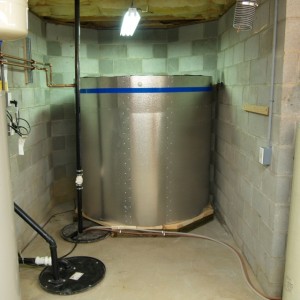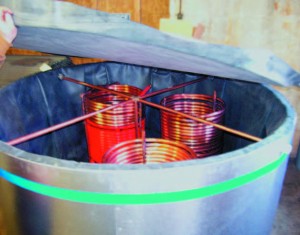1. SPACE HEATING

Generated from solar, coal/wood, off-peak electric and conventional fuels such as oil and gas where a buffer tank is required to eliminate cycling. Excessive boiler cycling damages control parts, reduces the combustion efficiency of the boiler and results in unwanted service calls. A boiler combined with heat storage increases customer satisfaction because it all but eliminates “cold” calls.
a. Warm water baseboard
Hydronic baseboard can heat an entire home when properly designed according to a calculated heat loss. It just takes more baseboard for warm water applications. According to the water temperature chart, baseboard will deliver 228 Btu’s per foot with 120 Deg. F. water, 274 Btu’s per foot with 130 Deg. F. water or 335 Btu’s per foot with 140 Deg. F. water.
b. Warm air furnaces and heat pump systems
In warm air – rather than hot air – applications, larger sized ducts are required to move Btu’s at a CFM adequate for the job. The STSS in-tank heat exchangers and the duct water- to- air heat exchangers are designed to provide 100% of the home heating down to a tank temperature of 120 Deg. F., at design outdoor temperature.
c. Radiant floor heating
When combined with heat storage, radiant floor heating is the best method for heating a home because tank temperatures can be as low as 95 Deg. F. and still provide 100% of the designed heating load. This means that the storage tank can be smaller than for higher temperature applications. Radiant floor heating has an additional benefit. Thermostat settings can be five to seven degrees lower than conventional heating system settings. This will increase efficiency by 20% to 35% compared to conventional distribution. It is important to note that, although the thermostat setting has been lowered, the comfort level remains high.
d. Solar heating
Solar energy requires the use of low temperature heating distribution methods. Warm air distribution and radiant floor heating distribution are the only two practical distribution methods because they operate at the lowest tank temperatures therefore, allow the solar collectors to transfer more heat than any other distribution method. The lower the tank temperature the greater benefit from the solar collectors. Because domestic hot water comes from a well or a city source that is between 50 and 60 Deg. F., solar domestic hot water applications should be included with every space heating system.
2. DOMESTIC WATER HEATING
 a. Solar domestic water heating
a. Solar domestic water heating
STSS has a cost effective line of equipment for residential and small commercial solar domestic water heating. These tanks can be used with any quality solar collector on the market.
The tanks commonly used for these solar applications are 184, 228, 275 and 328 gallon capacity tanks.
The 184 gallon tanks will provide sufficient storage capacity for the output of two 4′ by 8′ solar collectors.
The 228 tank will provide for three collectors.
The 275 tank will provide for four collectors.
The 328 tank will provide for five or more collectors. 328 gallon tanks are often installed with four collectors to improve the efficiency of the collectors.
Most of the water heaters on the market are limited to 120 gallon capacity because larger tanks can’t be moved through most doorways. The STSS tanks have solved the problem with tanks crated at 19 inches wide.
STSS solar domestic water heaters come with a double stacked coil specifically designed for solar domestic water heating. This coil qualifies as a double-walled heat exchanger.
An important option that can be included in the solar tank is an electric backup element with a control. This feature can replace the need for an additional water heater and will provide hot water when the sun isn’t shining.
b. The OPES Water Heater
The OPES water heater is designed and built to resist the problems that shorten the life of the conventional water heater.
The elements last longer. The vertical spiral heat exchanger separates the elements from the mineral-laden water supply eliminating mineral buildup on the elements and in the tank.
3. HEAT EXCHANGE COILS
a. For Space Heating and Domestic Water Heating
All STSS heat exchange coils are constructed from 3/4 inch copper in a vertical spiral configuration, 22 inches in diameter and 42 inches high. They are self-supporting and can stand alone on the bottom of the water storage tank.
This coil design allows for heat input by moving water from the top to the bottom of the coil. For heat output, water is moved from the bottom to the top of the coil. This method of heat transfer allows for undisturbed heat stratification in the tank. The coils automatically purge themselves of air on startup.
Two sizes are available for space heating and conventional water heating: 120 and 180 feet.
The 120 foot coil is rated at 26,400 Btu’s with 120 Deg. F. average tank temperature. (Part No. 425)
The180 foot coil is rated at 39,600 Btu’s with 120 Deg. F. average tank temperature. (Part No. 427)
The Btu output rating of these coils is based on a series of tests done by the Department of Engineering at Bucknell University. These are rated at the point at which the stored energy is technically depleted.
b. For Solar Domestic Water Heating
The heat exchange coils for solar/domestic water heating were specifically designed as a stacked pair of coils, 22 inches in diameter and 43 inches high. The bottom coil is 90 feet long and is rated at 22,000 Btu’s. It is self-supporting and can stand alone on the bottom of the water storage tank. The solar-generated heat enters the top of the bottom coil and returns to the collector from the bottom of the coil. The position of the coil at the bottom of the tank assures the coolest tank temperature for the best solar results.
The top coil is the domestic hot water take-out coil. It is located at the top of the tank where the water is the hottest. City or well water feeds the bottom of that coil and exits the top of the coil. (This solar coil is Part No. 424.)
4. TANK PORTS AND PENETRATIONS
Ports in two sizes are available for pass throughs above the water line; one for 3/4 inch copper pipe (Part No. 438) and one for 1 inch copper pipe (Part No. 439).
For below the water line, two ports are available:
1. An Open loop port with a 1 inch female threaded fitting. (Part No. 436)
2. A 1 inch element flange port with a 1 inch female threaded fitting and octagon box. (Part No. 485)
A solar return compression flange with one inch threaded fitting is located above the water line for an open loop drainback collector. (Part No. 436S)
Each tank order must include the size and number of these ports.
5. “FIRESITE” TANKS FOR ON-SITE FIRE PROTECTION
These tanks, like all other tanks manufactured by STSS CO INC, have an aluminum outer shell, two inches of insulation on the top, sides and bottom and are lined with EPDM. The Firesite tanks are built on the same concept as all other STSS water storage tanks. They are collapsed and crated in a narrow crate which can easily be moved through most doorways. They are light weight and easy to handle.
Most important, the Firesite tanks are of high quality, they are durable and have a longer life expectancy than steel. Firesite tanks have been used by the fire protection industry for over ten years with outstanding performance.
All Firesite tanks come with a suction vent cover with bug and rodent screen.
There is one penetration above the water line. That is an overflow port.
Below the water line there are two ports. One is for the 3/4 inch or one inch automatic float fill valve and one is the large suction port near the bottom of the tank. All orders must include the size of the float fill valve and large suction port required for the installation.
Prices quoted include the 3/4″ float fill valve and 2 inch or 4 inch pump suction ports sized according to the tank size. There is an additional price for the 1inch float fill valve. Refer to the price list for standard ports. Call STSS for prices on non-standard ports.
6. POTABLE WATER PROCESSING AND STORAGE
The tanks designed for potable water storage have an aluminum outer shell, two inches of insulation on the top, sides and bottom and are lined with 40 mil white NSF PVC. This liner material is designed for drinking water applications. The size of the tank will determine the size of the openings into and out of the tank. These openings or ports will be specified when the order is placed.
7. STSS ENERGY MANAGEMENT CONTROL (EMC)
This packaged control system automatically switches on the backup boiler when the heat storage tank is not warm enough to maintain room temperature. It isolates the fossil fuel system from the wood/solar/tank system and samples tank temperatures at the end of each boiler cycle. When the wood boiler is fired or the sun comes out, the system switches back automatically to the primary tank system thus using as little oil or gas as possible, yet getting every Btu available from the bank. This method improves solar collector efficiency and wood boiler efficiency.